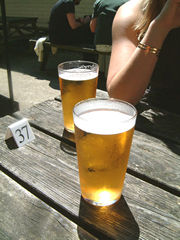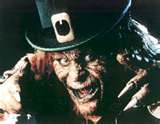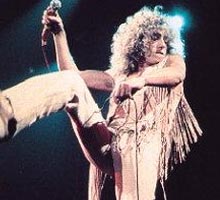Beaver & Cucumber
The Beaver & Cucumber was once a marvellous little pub in old London town, merrie England. Forcibly closed by strapping, violent public health officials in 1962, it is often mentioned wistfully by elderly alcoholics when they are afflicted by nostalgia, neuralgia, dementia, or any other condition that ends with “ia”. Among the myths and legends of the B & C are that it served the “best beer in the world” and had the “most attractive barmaids in the world”. This may be romantic nonsense but it seems to make people happy, so why knock it?
Erection[edit | edit source]
There had been a public house on the site of the pub, at the corner of Lisle Street and Mollyhouse Lane, London W1, since human memories began. The original wooden building is thought to have been blitzed by the Great Fire of London in 1666, and the straw-walled replacement was puffed down by a big bad wolf in 1701. It is thought to have suffered under a series of silly but forgettable names, like the Baker’s Arms and the Butcher’s Legs. The name “Beaver & Cucumber” was given to the pub sometime in the following century; legend has it that a passing leprechaun called Shorty told a story by that name in the saloon bar, which brought the house down (though not in the same manner as the wolf of 1701) and inspired the publican to put up a new sign there and then. Shorty is said to have spat on some pork scratchings with magic Oirish saliva and blessed the pub for ever after. But that didn’t work, did it, because there’s a branch of Starbucks there now.
Who drank here?[edit | edit source]
Oscar Wilde, Bob Hope, Samuel Pepys, Mae West, Joseph Stalin, Satan, Reg Varney, Cliff Richard, Jimmy Page, Cheryl Baker, Leif Garrett, Tracey Emin and Billy the Kid are all said to have consumed alcoholic beverages on the premises. Jack Benny and Roger Daltrey are said to have frequented it but refused to buy any drinks there. There were regular “lock-ins”, whereby the staff stopped customers leaving by force, and many rowdy hullabaloos.
What was the beer like?[edit | edit source]
Tasty and very well kept, at precisely the correct temperature and with a fine head, according to tales. The pub not only sold the loveliest beers of the time but also brewed its own special celebration ale, Well-Moistened Beaver, in a dark place in the cellar. It also sold spirits and slimline tonic.
Tell me about those barmaids[edit | edit source]
They had voluminous but perky breasts, child-bearing hips, slim waists, and smiles that lit up the room. Some have latterly been compared, looks-wise, to Nicole Kidman, Michelle Pfeiffer, Jane Russell and Carol Vorderman. In the 1760s the Vorderman lookalike used to run a popular daily words-and-numbers quiz called Countdown in the pub.
Fun and games[edit | edit source]
Many games and pranks were played at the B & C, including skittles, whist, cribbage, darts, knock down ginger, and rip the moustache off the ginger bloke. A fun time was had by all, except for ginger blokes with moustaches.
Why was it demolished?[edit | edit source]
You tell me. London’s officious public health numpties heard a rumour about a rancid meat pie and went right over the top.
Comeback in 2012?[edit | edit source]
The UK government and the National Trust have muttered about reviving this luvverly old boozer, perhaps to coincide with the Olympic Games in London in 2012, but nobody is taking them seriously. Nicole Kidman has reportedly expressed a serious lack of interest in appearing as an old-style barmaid. Starbucks say they want to stay put on the site.
Mollyhouse Lane[edit | edit source]
This lane was filled in by Irish navvies in 1933, but it is said that you can still hear the screams and cries of the prostitutes who were strolling about there, unlucky for them, when it happened. “Aargh! No! Please!” That sort of thing.



